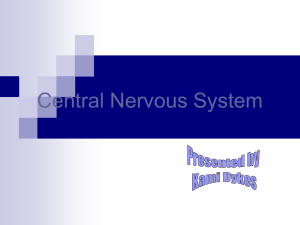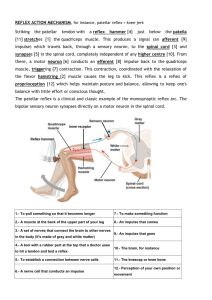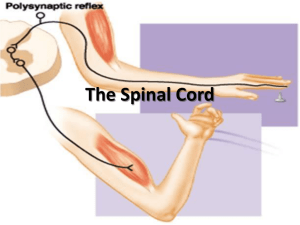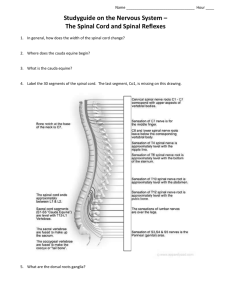Spinal Cord Physiology PPT
advertisement
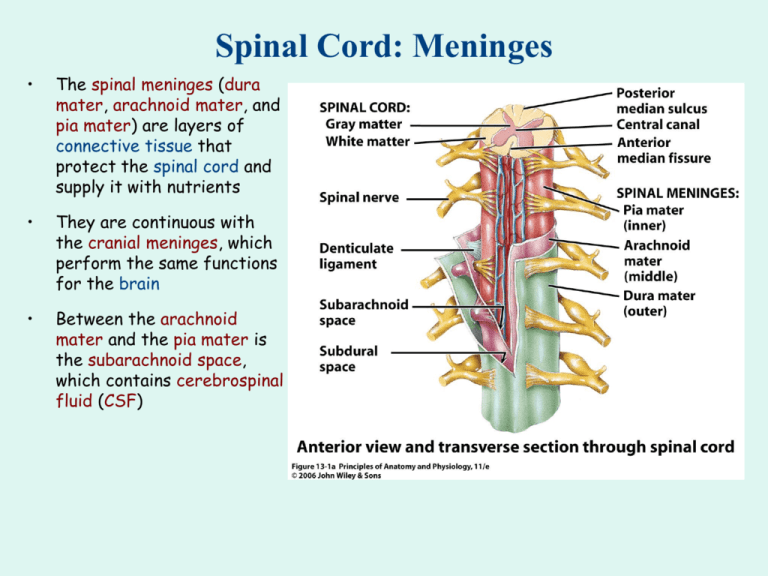
Spinal Cord: Meninges • The spinal meninges (dura mater, arachnoid mater, and pia mater) are layers of connective tissue that protect the spinal cord and supply it with nutrients • They are continuous with the cranial meninges, which perform the same functions for the brain • Between the arachnoid mater and the pia mater is the subarachnoid space, which contains cerebrospinal fluid (CSF) Spinal Cord: Spinal Tap • A spinal tap (lumbar puncture) is a procedure in which a needle is inserted into the arachnoid space in the lumbar region to withdraw CSF or administer medication Spinal Cord: External Anatomy • There are 31 pairs of spinal nerves (8 cervical, 12 thoracic, 5 lumbar, 5 sacral, and 1 coccygeal) • Bundles of axons called roots connect each nerve to the spinal cord • The dorsal root is sensory, the ventral root is motor • Each dorsal root has a “swelling” composed of cell bodies of sensory neurons, called the dorsal root ganglion • Nerves to and from the upper limbs form the cervical enlargement, nerves to and from the lower limbs form the lumbar enlargement • The spinal cord tapers at its end to form the conus medullaris • Lumbar, sacral, and coccygeal nerves hang below the conus medullaris to form the cauda equina (“horse’s tail”) Spinal Cord: Internal Anatomy • The white matter is permeated by the anterior median fissure and the posterior median sulcus • The gray matter forms an “H” or butterfly, with the central canal in the middle of the gray commissure • The ventral horns contain somatic motor nuclei, whereas the dorsal horns contain somatic and autonomic sensory nuclei • The anterior white commissure connects the white matter on right and left sides • The ventral and dorsal gray horns divide the white matter into the ventral white columns, dorsal white columns, and lateral white columns Spinal Nerve Anatomy • Nerves are similar in organization to muscles • Groups of axons are bundled in fascicles • The entire nerve is wrapped in the epineurium • The perineurium surrounds each fascicle • The endoneurium surrounds each axon Spinal Nerve Anatomy Spinal Cord Tracts • Spinal tracts are the “highways” for information traveling between the brain and the body • Sensory tracts take information from sensory organs to the brain • Motor tracts carry impulses from the brain to muscles and target organs • Spinal cord gray matter is a site where excitatory and inhibitory impulses are summed Dermatomes • Dermatomes provide sensory input to the CNS via the dorsal roots of spinal nerves, or via the trigeminal nerve (cranial nerve V) • Can be used diagnostically to assess spinal nerve damage • Can explain referred pain • Can be used to determine how to administer anesthesia to portions of the body (e.g. phantom pain) • May be a remnant of our earlier segmentation Reflex Arcs • The pathway followed by a nerve impulse that produces a reflex is a reflex arc • A sensory receptor responds to a stimulus • A sensory neuron conveys the impulse to the spinal cord • Integration takes place in the spinal cord, conveying the impulse to a motor neuron through a monosynaptic or polysynaptic reflex arc • The motor neuron conveys the impulse to the part of the body that will respond • The effector organ (an organ, muscle, or gland) responds to the motor impulse • Somatic reflexes involve skeletal muscles, autonomic reflexes involves smooth muscle and glands Reflex Arcs • Reflex Arcs provide an illustration of homeostasis Stretch Reflex • The stretch reflex occurs in response to stretching of muscle • The stretch reflex is monosynaptic and ipsilateral • Stretching simulates the muscle spindle organ • Impulse is sent along a somatic sensory neuron to the dorsal horn • In the spinal cord the sensory neuron synapses with a motor neuron in the ventral horn • An excitatory motor impulse is conveyed along the motor neuron to the muscle, which contracts • The sensory neuron also synapses with another motor neuron • An inhibitory motor impulse is sent to the antagonistic muscle Stretch Reflex • The muscle spindle organ “notifies” the spinal cord if it is being stretched Crossed Extensor Reflex • The crossed extensor reflex is polysynaptic and contralateral • The crossed extensor reflex is an intersegmental reflex • Painful stimulus to right foot sends impulse along sensory neuron • In the spinal cord the sensory neuron synapses with several neurons on the same side and on the opposite side • Motor neurons on the same side cause flexion of the limb • Motor neurons on the opposite side cause extension of the opposite limb • Inhibitory motor neurons cause inhibition of necessary antagonistic muscles on both sides (not shown) Movements of the Lower Leg Involuntary movement Voluntary movement




